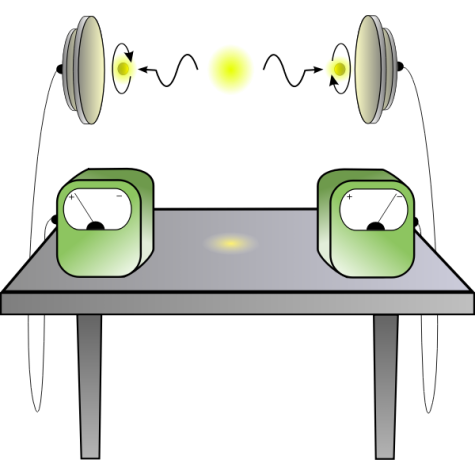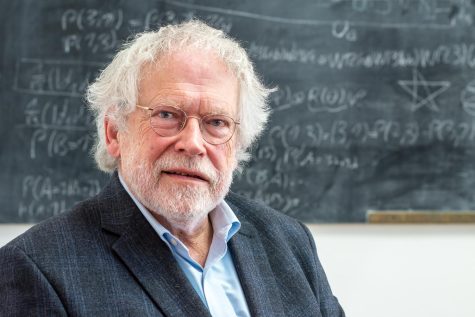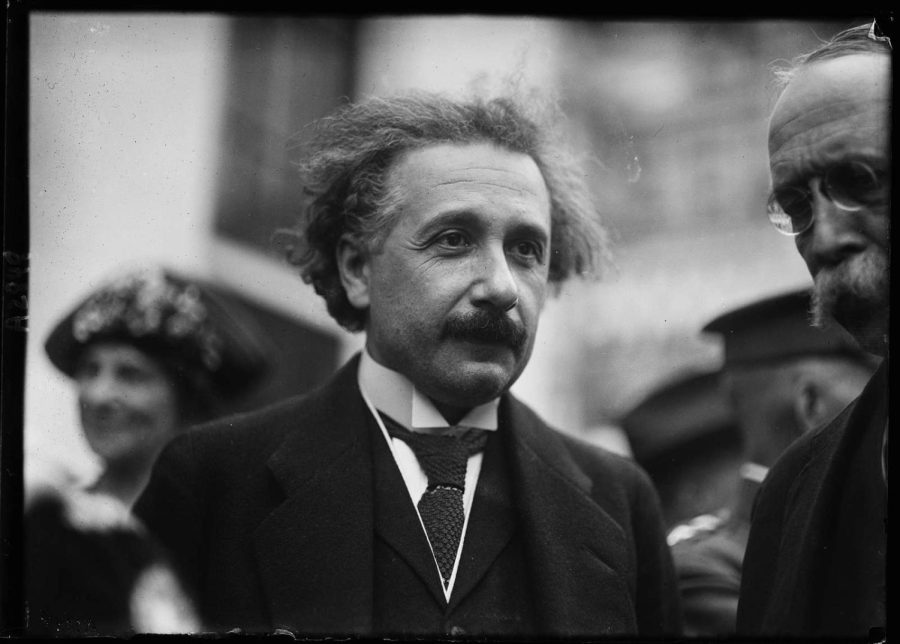Einstein Was Wrong
Albert Einstein, one of the most famous, Jewish scientists.
Imagine you and your friend are arguing over which movie to watch. In order to solve this argument, your friend places a coin in one of her palms, leaving the other empty, and she places her hands behind her back. She tells you to pick a hand, and if you pick the one with the coin, then you get to choose the movie. You choose her right hand, which turns out to be empty, and you immediately know that her left hand holds the coin. This means that the hand with the coin and the empty hand are entangled. This quantum mechanics phenomenon, known as quantum entanglement, suggests that two particles, no matter the distance, can be intertwined together, and information between them travels faster than the fastest thing in the universe: the speed of light. Albert Einstein was gravely disturbed by this and deemed it a “spooky action at a distance.”

( Royal Society uploader.)
Now, why was Einstein, one of the most acclaimed physicists, so bothered by this branch of physics? Well, there was a lot of debate over quantum mechanics’ stance as a credible science. It was controversial due to its complexities, so much so that acclaimed 20th-century theoretical physicist John Wheeler agreed with Einstein and said, “If you are not completely confused by quantum mechanics, you do not understand it.” However, this all changed through this year’s Nobel Prize in Physics, which was awarded to Alain Aspect, John Clauser, and Anton Zeilinger for their breakthrough research in quantum mechanics. All of this is really exciting, but to understand why they received the award and what their findings were, we must first understand its history.
Going back to Einstein, the reason why he had such trouble with quantum mechanics is because he based all of his theories on locality, meaning an object is only directly influenced by its immediate surroundings. This concept does not apply to this branch of physics. Quantum mechanics, which mainly focuses on things at a subatomic scale (protons, electrons, and neutrons), essentially disproves the idea that if you know the starting conditions of a particle, then you will know the ending conditions. For instance, if I bake a cake and leave it on the counter to eat for later, I would expect it to be there when I return. However, when I came to get my cake, it was eaten by my family, and gone! This relates to quantum mechanics because it proves how just because I know the cake was there when I left it, does not mean it will be there when I return. In order to understand why that is, Einstein and other notable physicists of the 20th century wrote a paper known as EPR in an attempt to understand why locality does not apply to quantum physics, and it specifically focused on entangled electrons.
Because of this article , quantum mechanics was declared an incomplete theory—not only because of its odd behavior, but since particles are constantly in motion, they are unable to spin in both a definite position and definite direction simultaneously.

The article also coined the EPR Paradox, which tried to conceptualize quantum entanglement. Since electrons are in constant motion, occasionally they become intertwined (like when you chose a coin from your friend’s hand). This causes the electrons, which spin simultaneously in all directions, to instead immediately spin in one direction, opposite of one another. Einstein did not like this concept and tried to disprove it. Thus, the EPR Paradox was born, and it suggests that there are hidden variables that have a direct effect on the direction the entangled electrons are spinning in. Meaning, the entangled electrons don’t automatically get the memo to spin in one direction, because there is a hidden variable that gradually influences them to do so. Imagine you are having lunch with your friend and you are either ordering a Coke or Dr. Pepper, depending on what your friend orders. You will not know she is getting a soda, nonetheless which soda she is ordering until she says, “Hey, I’m gonna get a Dr. Pepper.” Yet, Einstein suggests that you already knew she was going to get a Dr. Pepper because there was this hidden variable. He believes that the process of realization was more gradual and affected by a combination of factors.

However, other scientists were not too fond of this concept, and preferred the spooky aspect to quantum entanglement. These scientists would say that when getting lunch with your friend, before she orders, she is getting both a Dr. Pepper and a Coca Cola, and she will not know until she orders. Crazy, right? This is known as superposition, meaning a particle is in all states at the same time until it is measured. Jeez, no wonder Einstein hated this concept!
In an attempt to solve this ongoing debate, physicist John Bell came up with a test that determined whether there were hidden variables, or if the particle only chooses a definite direction to spin in upon measurement. Which, in turn, would have an immediate effect on its entangled partner, which is farther away. He argued in opposition to Einstein. However, his argument was not concrete, and added to the sense of uncertainty.
On October 6, 2022, this ongoing debate was finally resolved. Scientific American published an article explaining this year’s physics Nobel Prize proves Einstein was wrong.

To break down what they discovered, imagine we took two twins, Bobby and Tommy, and placed them on opposite sides of the Earth. Let’s say, Bobby is in Siberia, and Tommy is living it up in New York City. It is widely accepted that the only thing that matters to these people is where they live, and if they decided to communicate, they would have to via the Internet… or send letters. Yet, what if I told you that if this was in the subatomic realm, meaning none of this matters. To go even further, imagine that the only thing important to them was their favorite color. Their favorite color can either be blue or green, however, they don’t have a definite favorite color, they just know it can either be blue or green. One day, someone asks Tommy what his favorite color is and he finally decides after some long years that his favorite color is green. Automatically, as if it is twin telepathy, Bobby knows he is stuck with blue as his favorite color.
The reason why these three scientists won is that they proved the facts stated above. In order to prove this theory, the three each made breakthrough discoveries. Aspect closed all the loose ends and loopholes of Bell’s theory. Clauser developed Bell’s theories and made physical experiments possible (sort of like the labs we do in school), which confidently proved Einstein wrong. Finally, Zeilinger used entangled quantum states and applied this knowledge to quantum teleportation. Their research makes quantum mechanics more understandable, which is groundbreaking in the physics world because it settled the ongoing debate.

Kylee Harel is a junior at Milken Community School, and this is her first year writing for The Roar. Through journalism, Kylee hopes to express her love...




Austin Cefalu • Jan 11, 2023 at 12:57 pm
Fascinating